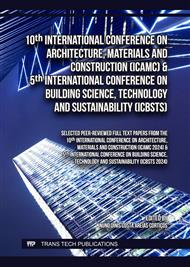[1]
G. O'Reilly and G. Calvi: A seismic risk classification framework for non-structural elements. Bull. Earthquake Eng. 19:5471–5494 (2021)
DOI: 10.1007/s10518-021-01177-y
Google Scholar
[2]
M. Papathoma-Köhle, A. Ghazanfari, R. Mariacher, W. Huber, T. Lücksmann and S. Fuchs: Vulnerability of Buildings to Meteorological Hazards: A Web-Based Application Using an Indicator-Based Approach. Appl. Sci. 13, 6253 (2023)
DOI: 10.3390/app13106253
Google Scholar
[3]
European Commission. Directorate General for Climate Action: EU-level technical guidance on adapting buildings to climate change - best practice guidance. Publications Office of the European Union, Luxembourg (LU) (2023). Retrieved May 22nd, 2024 from https://data.europa.eu/doi/
Google Scholar
[4]
R. Ramos, A. Silva, J. de Brito and P. Lima Gaspar: Methodology for the service life prediction of ceramic claddings in pitched roofs. Construction and Building Materials, 166 (2018), pp.386-399
DOI: 10.1016/j.conbuildmat.2018.01.111
Google Scholar
[5]
C. Pereira, E. Hamadyk and A. Silva: Probabilistic analysis of the durability of architectural concrete surfaces. Applied Mathematical Modelling, 77 (2020), pp.199-215
DOI: 10.1016/j.apm.2019.07.031
Google Scholar
[6]
C. Ferreira, J. Barrelas, A. Silva, J. de Brito, I. S. Dias and I. Flores-Colen: Impact of Environmental Exposure Conditions on the Maintenance of Facades' Claddings. Buildings 11(138) (2021)
DOI: 10.3390/buildings11040138
Google Scholar
[7]
C. Hayles, M. Huddleston, P. Chinowsky and J. Helman: Quantifying the Effects of Projected Climate Change on the Durability and Service Life of Housing in Wales, UK. Buildings 12(184) (2022)
DOI: 10.3390/buildings12020184
Google Scholar
[8]
Dipartimento della Protezione Civile, Presidenza del Consiglio dei Ministri: Che cos'è il rischio? Available at: https://www.protezionecivile.gov.it/it/approfondimento/che-cos---il-rischio-/
Google Scholar
[9]
A. Fragomeli, A. Galasco, F. Graziotti, et al.: Performance of masonry buildings in the seismic sequence of Central Italy 2016 - Part 2: case studies of affected municipalities. In: Progettazione Sismica Vol. 8(3) (2017), pp.75-98.
Google Scholar
[10]
A. De Sortis, G. Di Pasquale, M. Dolce, S. Gregolo, S. Papa and G. F. Rettore: Linee guida per la riduzione della vulnerabilità di elementi non strutturali arredi e impianti. Presidenza del Consiglio dei Ministri, Dipartimento della Protezione Civile, Roma (2009).
Google Scholar
[11]
A. Masi, V. Manfredi, M. Vona, F. Braga and A. Salvatori: Prestazioni delle tamponature e tramezzature negli edifici in c.a.: implicazioni progettuali e costruttive alla luce dell'esperienza del terremoto dell'Abruzzo 2009. In: Progettazione Sismica Vol 3 (2010), pp.51-66.
Google Scholar
[12]
E. A. Fierro, C. L. Perry and S. A. Freeman: Reducing the Risks of Nonstructural Earthquake Damage - A Practical Guide. Federal Emergency Management Agency (FEMA-74), September 1994.
Google Scholar
[13]
D. Perrone, P. M. Calvi, R. Nascimbene, E. C. Fischer and G. Magliulo: Seismic performance of non‑structural elements during the 2016 Central Italy earthquake. Bull. Earthquake Eng. 17:5655-5677 (2018)
DOI: 10.1007/s10518-018-0361-5
Google Scholar
[14]
Z. Ahmad, H. A. Ahmed, K. Shahzada and Y. Li: Vulnerability of Non-Structural Elements (NSEs) in Buildings and Their Life Cycle Assessment: A Review. Buildings 14(170) (2024)
DOI: 10.3390/buildings14010170
Google Scholar
[15]
K. W. Riley and J. L. Heiman: Water and salt migration through a sandstone coping. Mat. Struct. 29(7) (1996), p.436–443
DOI: 10.1007/BF02485994
Google Scholar
[16]
E. Matteuzzi: Umidità e infiltrazioni d'acqua: cause, diagnosi e rimedi. Accessible at https://www.teknoring.com/guide/guide-architettura/umidita-infiltrazioni-acqua-cause-diagnosi-rimedi/
Google Scholar
[17]
S. Kim, D. Zirkelbach and H. M. Künzel: Wind-driven rain exposure on building envelopes taking into account frequency distribution and correlation with different wall orientations. Building and Environment, 209: 108665 (2022). https://doi.org/10.1016/j.buildenv. 2021.108665
DOI: 10.1016/j.buildenv.2021.108665
Google Scholar
[18]
C. Jia, A. Wang, L. Zong et al.: Structural optimization and performance improvement of rock drill seals based on orthogonal test. J. Eng. Appl. Sci., 71:14 (2024)
DOI: 10.1186/s44147-023-00354-x
Google Scholar
[19]
A. Mansourian, S. Shabani and K. Siamardi: Evaluation of fracture energy and durability properties of pavement concrete incorporating blends of durable and non-durable limestone Aggregates: RSM modelling and optimization. Theoretical and Applied Fracture Mechanics, 131: 104374 (2024)
DOI: 10.1016/j.tafmec.2024.104374
Google Scholar
[20]
S. Kim, Y. Jeong, M. Kwon and J. Kim: Combined deterioration effects of freeze-thaw and corrosion on the cyclic flexural behaviour of RC beams. Journal of Building Engineering, 84(3): 108564 (2024)
DOI: 10.1016/j.jobe.2024.108564
Google Scholar
[21]
B. P. Jelle: Accelerated climate ageing of building materials, components and structures in the laboratory. J Mater Sci., 47 (2012), p.6475–6496. https://doi.org/10.1007/ s10853-012-6349-7
DOI: 10.1007/s10853-012-6349-7
Google Scholar
[22]
S. Kaewunruen, L. Wu, K. Goto and Y. Najih: Vulnerability of Structural Concrete to Extreme Climate Variances. Climate, 6(2): 40 (2018)
DOI: 10.3390/cli6020040
Google Scholar
[23]
V. M. Joshima, M. A. Naseer and E. Lakshmi Prabha: Assessing the real-time thermal performance of reinforced cement concrete roof during summer- a study in the warm humid climate of Kerala. Journal of Building Engineering, 41:102735 (2012)
DOI: 10.1016/j.jobe.2021.102735
Google Scholar
[24]
Y. Sun, T. Wu and Z. Cao: Wind vulnerability analysis of standing seam roof system with consideration of multistage performance levels. Thin-Walled Structures, 165:107942 (2021)
DOI: 10.1016/j.tws.2021.107942
Google Scholar
[25]
J. Estephan, C. Feng, A. Gan Chowdhury, M. Chavez, A. Baskaran and M. Moravej: Characterization of wind-induced pressure on membrane roofs based on full-scale wind tunnel testing. Engineering Structures, 235:112101 (2021). https://doi.org/10.1016/j.engstruct. 2021.112101
DOI: 10.1016/j.engstruct.2021.112101
Google Scholar
[26]
P. R. Sparks, S. D. Schiff and T. A. Reinhold: Wind damage to envelopes of houses and consequent insurance losses. Journal of Wind Engineering and Industrial Aerodynamics, 53(1-2) (1994), p.145–155
DOI: 10.1016/0167-6105(94)90023-X
Google Scholar
[27]
D. J. Smith and F. J. Masters: A study of wind load interaction for roofing field tiles. In Proceedings of the 14th International Conference on Wind Engineering, Porto Alegre (Brazil) (2015).
Google Scholar


